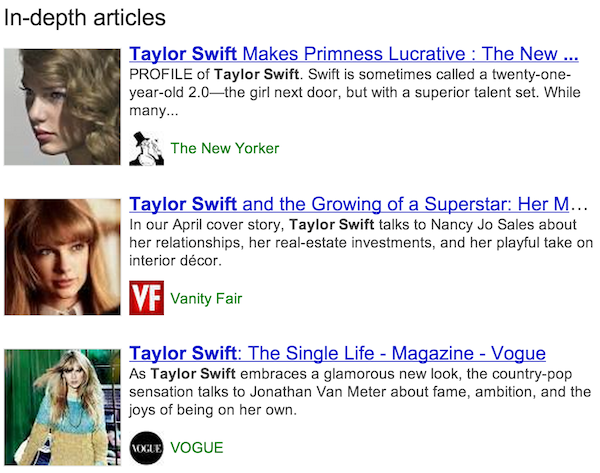
When big news breaks, readers clamor for updates — but they also yearn for context. For example, when word got out Monday afternoon that Jeff Bezos had spent $250 million to become the new owner of The Washington Post, there was suddenly a demand for all kinds of information. Who are the Grahams? How long have they owned the paper? What kind of leader has Bezos been at Amazon? What’s the status of other historic newspapers — have any others been purchased recently?
Some of this information would have been clear after a quick Google search, but piecing together a full portrait of the significance of what happened would likely have taken a combination of queries and resources — maybe a Wikipedia article, some breaking blog posts, a couple of company biographies — to put it all together.
Google wants to change that. Today, they announced a new search feature that aims to put in-depth and longform coverage of people, places, events and themes at your fingertips.
“We’ve done research that suggests this is a fairly common kind of information need, not a specific need but a broad interest,” says Google product manager Jake Hubert. For example, Hubert says that while most people who search for the term “YouTube” are looking for a video, or to be navigated to YouTube.com, some might be looking for, say, the essential essay on YouTube’s history, operations, business model and leadership. The new algorithm will help you do that.
It’s key to note that unlike doing an image search and specifying a type (“face” “clip art” “animated”), or a doing a news search and specifying a time period (“within the last month” “archives”), the in-depth feature is not something you can choose. Instead, if you search a broad term — “happiness” and “Taylor Swift” are two examples — you might see an inset box with a few headlines from major publications pop up.
Hubert wouldn’t go into detail about how the algorithm works, so we don’t know what factors are incorporated into the final results — renown of publication, length of article, number of views, publishing date. (He was clear, however, that there is absolutely no element of human curation.)
“This content can come from anywhere on the web. You’ll find content from well-known publishers, but also from lesser known publications and blogs,” he said. “Sometimes, for local angles on an in-depth topic from your hometown or a particularly niche subject, a smaller, lesser known publication may actually have the best in-depth content.”
Of course, as the feature rolls out over the next few days, publishers will increasingly want to know how to get their own content promoted as seminal works on a topic. To that end, Google has provided some support via their help center. Structuring article data in a certain way — specifically annotating HTML so that authors, headlines, text body, images, date are clearly demarcated — will help Google surface the kind of in-depth articles the algorithm is looking for. For example, Hubert was particularly proud that doing a search for “Gloria Steinem” not only turned up a couple of key interviews and profiles, but also her fundamental 1969 essay, “After Black Power, Women’s Revolution.” To find that kind of needle in the haystack of the internet, it can really help if the author is clearly marked.
One possible result of the new search might be that more eyes are turned toward content produced by journalists in newsrooms rather than the aggregators we have come to rely on when looking for background information — Wikipedia, IMDb, or WebMD. It also suggests that Google is aware of an information gap that others are also trying to fill, a centralized hub for background and context on an issue. The motivation is similar to what, for example, Fast.Co Labs was aiming for when its team started experimenting with stub posts, which Chris Dannen described as a “way of telling the reader, ‘If you’re not up on the story, if you need context, go back and read the stub and it will make sense why this is timely, and why this is a person we’re talking to.’”
Google says they’ll keep experimenting with the feature depending on feedback, but they’re excited to take steps towards surfacing the content that remains useful and interesting long after its published, but can easily be lost in the fire hose of content that is the internet. But there’s also a note of warning to publishers that increasingly advanced search may be doing a better job of giving readers what they want than the publications are themselves.
“It’s a tricky thing. Unless you really know what publications have written this kind of content, you’re going to find yourself going to these publications and trying to find them. We really want to help users find it all from across the web,” says Hubert. “This makes it easier for users to discover this kind of content, that used to be not as easy to discover.”